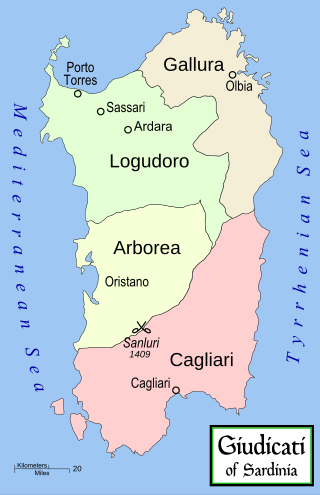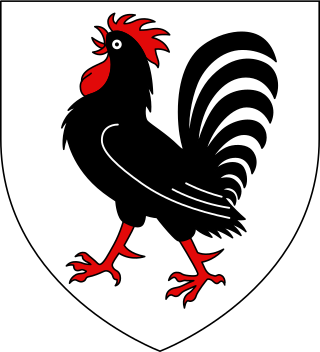
Comita III was the giudice of Logudoro, with its capital at Torres, from 1198 until 1218. He was the youngest of four sons of Barisone II of Torres and Preziosa de Orrubu. He ruled at a time when the great families, usually foreign, were superseding the giudici in power and influence on Sardinia.

William I, royal name Salusio IV, was the judike of Cagliari, meaning "King", from 1188 to his death. His descendants and those of his immediate competitors intermarried to form the backbone of the Italian Aristocracy, and ultimately their descendants in the Medici clan are precursors to, and definers of later royalty and claims thereto.

The Judicate of Cagliari was one of the four kingdoms or judicates into which Sardinia was divided during the Middle Ages.

The kings or judges of Gallura were the local rulers of the northeast of Sardinia during the Middle Ages. Theirs was the closest kingdom to Corsica.

The kings or judges of Cagliari were the local rulers of the south of Sardinia during the Middle Ages. Theirs was the largest kingdom and for the eleventh through twelfth centuries contested the supremacy on the island with that of Logudoro. It was often an ally of the Republic of Pisa and an early supporter of Western monasticism.

Ugolino Visconti, better known as Nino, was the Giudice of Gallura from 1275 or 1276 to his death. He was a son of Giovanni Visconti and grandson of Ugolino della Gherardesca. He was the first husband of Beatrice d'Este, daughter of Obizzo II d'Este. His symbol was a cock.

The Judicate of Gallura was one of four Sardinian judicates in the Middle Ages. These were independent states whose rulers bore the title iudex, judge. Gallura, a name which comes from gallus, meaning rooster (cock), was subdivided into ten curatoriae governed by curatores under the judge. In the 13th century, the arms of Gallura contained a rooster.
Elena was the daughter and successor of Barisone II of Gallura and was named after her mother Odolina of the Lacon family. First queen regnant in Sardinia, she ruled Gallura from the death of her father until her own death, though she was eclipsed by her husband after 1207.
Lamberto Visconti di Eldizio was the Judge of Gallura from 1206, when he married the heiress Elena, to his own death. He was a member of the Visconti family of Pisa and the first of that dynasty to rule in Sardinia, where they lasted in Gallura for almost another century.
Ubaldo II Visconti, son of Lamberto di Eldizio and Elena de Lacon, was the Judge of Gallura from 1225 to his death in 1238. He ruled every giudicato on the island of Sardinia at one point or another save Arborea.
Biagio was the Archbishop of Torres from 1 December 1202 to his death late 1214 or early 1215.
Adelasia (1207–1259), was the Judge of Logudoro from 1236 and Judge of Gallura from 1238.
Benedetta was the daughter and heiress of William I of Cagliari and Adelasia, daughter of Moroello Malaspina. She succeeded her father in January or February 1214.
JohnVisconti was the Judge of Gallura from 1238 to his death. He was a member of the Visconti dynasty of Pisa.

Joannaof Gallura, also known as Giovanna Visconti, was the last titular Judge (giudicessa) of Gallura. Joanna claimed her rights in Sardinia to no avail and eventually sold them to her relatives, the Visconti of Milan, who later sold them to the Crown of Aragon. She is mentioned passingly by Dante Alighieri in the Divine Comedy. Her father, a friend of Dante's, but consigned to Purgatory with the other negligent rulers, asks her to be reminded of him.
William II Salusio V was the Judge of Cagliari from 1232 to his death. His Christian name was William, but his regnal name was Salusio, based on ancient Cagliaritan traditions which alternated their rulers between the forenames Torchitorio and Salusio. He would have been called Salusio in official documents, though he is known historically as William, after his grandfather, William I.

Marianus II was the Judge of Logudoro from 1218 until his death. He was an ally of the Republic of Genoa and enemy of Pisa.
Ubaldo I Visconti was the de jure overlord of the Giudicato of Cagliari from 1217. He was a member of the Visconti family of Pisa, controlling Cagliari on behalf of his brother, who was judge jure uxoris from 1218.

Torchitorio III, born Peter, was the Judge of Cagliari from October 1163 to his deposition and arrest in 1188, after which he was never heard of again.

The House della Gherardesca was an old noble family of the Republic of Pisa, of Longobard origin. The family likely dates back as early as the 11th century.









